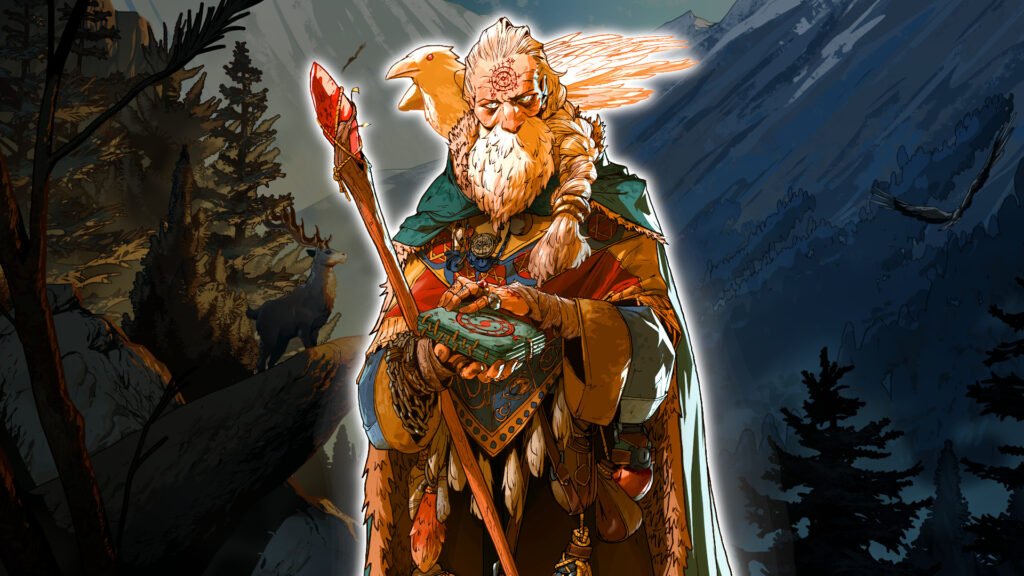
Back in 2025, readers at ENWorld named Legend in the Mist their most anticipated tabletop RPG of 2025. The game is a self-described “rustic fantasy TTRPG” that uses status tags rather than stats to tell stories. As of August, its core rules are widely available, so we can finally test whether Legend in the Mist was worth the hype.
Based on my time with its Quickstart guide alone, I can tell you that, for fans of narrative RPGs, things look very promising.

Legend in the Mist transports you to the kind of fantasy setting dreamt up by a Hayao Miyazaki or an Ursula Le Guin. Rather than dungeons, you’ll traverse dense woodlands or cloudy mountaintops, where unknowable supernatural beings leave their footprints side-by-side with those of more standard fauna. Your name and your values are as powerful as your bow or knife. Its stories feel more like legend or fairytale than the power fantasy you’d typically play out with polyhedral dice.
In Legend in the Mist, a character’s most important feature is their tags. These are single words or phrases that sum up aspects of their character. Groups of tags are known as ‘themes’, and they shape how your character interacts with the world.
For example, in the Quickstart, you’ll follow the journey of Gerrin, a young hero with the ‘Devotion to Family’ theme. This means he’s a good listener, but he has a significant weakness: ‘family is my soft spot’.
Rolling to resolve scenarios involves 2d6, but tags can add positive or negative modifiers to that roll, depending on the scene’s context. If you want to wield more significant influence over a roll, you can ‘scratch out’ traits, making them unavailable for future use temporarily (or, in some cases, forever).
Rather than complex stat blocks, anything that stands in your way is a Threat that’s bypassed by giving them status tags of a suitably high value. In combat, you might need to achieve a ‘harm’ status of four before your foe flees or dies. Or you might test another tactic and aim for the ‘convince’ status to talk your way out of danger. It’s a simple, elegant system that means the consequences of every encounter are tailored to the characters and the scene you’ve set up.

Perhaps the most fascinating part of this fiction-first game is how its characters evolve over time. Each theme your character possesses offers its own unique goal that your character dreams of fulfilling. Sometimes, however, your actions will counter these goals rather than contribute to them. The third time you ‘abandon’ a quest in this way, you’ll lose it forever and replace it with a new goal as your character’s wants change. Alternatively, if you make progress on that quest three times, you instead complete it and replace it with another.
In this way, your character’s experiences create new traits for them to lean upon in future adventures. Similarly, indulging in a character’s weaknesses can shape who they are. The third time that you invoke a weakness tag on a roll, you gain a new positive tag for its theme, as your struggles have encouraged personal growth. Additional tags can be picked up from allies and treasures you discover on your journeys, as well as from the temporary conditions your character endures.

Legend in the Mist refuses to define a character in numerical terms. Instead, it uses language to represent their progress. It places the emphasis on a person’s internal journey as much as their external achievements. It asks you to consider what success looks like in your fantasy stories.
In a classic dungeon crawl, your end goal is to hoard XP by killing the most goblins and netting the most loot. Even in modern times, your typical Dungeons and Dragons game requires you to consider your character from a meta perspective rather than a narrative one. That low Intelligence score often isn’t a significant character flaw; it’s a ‘dump stat’ you’ve chosen to ignore so that your character functions within its class’ mathematical limits.
In Legend in the Mist, the call to adventure is not a desire for wealth, fame, or reality-bending magical powers. It is a deeply personal motivation that will alter as your character leaves home to explore the world – as well as themselves.
2025 truly has been the year of the fiction-first RPG. Darrington Press’ Daggerheart has been the talk of the tabletop this year, with regular playtests and exciting developments (plus genuinely interesting design) keeping eyes on it since release. Similarly, after one of the most successful Kickstarter campaigns of all time, the Cosmere RPG has introduced another new system that dedicates as much space to stories as it does to tactical combat.

In ENWorld’s list of hotly anticipated games, Legend in the Mist trumped all of these titles. Now, it’s time to see if it can sustain the hype – and if the trend of high-profile narrative RPGs will continue.
Want to talk more about Legend in the Mist? Join us in the Wargamer Discord. Or, for more on recent tabletop RPGs, here’s all you need to know about this year’s DnD release schedule.
